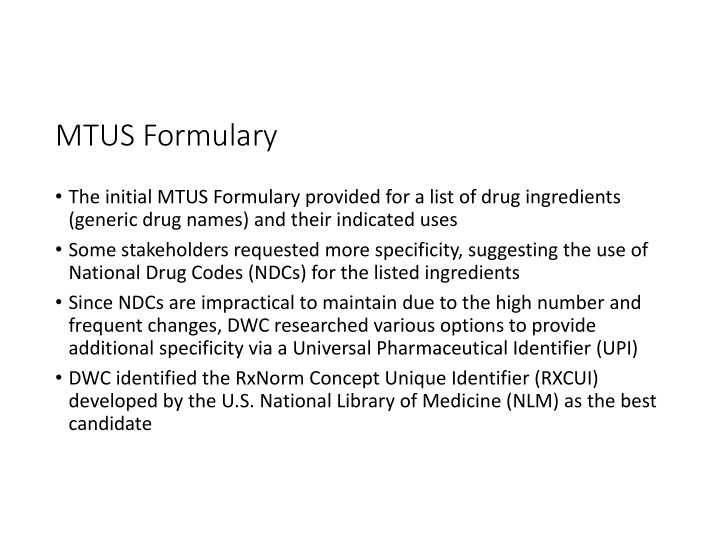



MTUS Formulary • The initial MTUS Formulary provided for a list of drug ingredients (generic drug names) and their indicated uses • Some stakeholders requested more specificity, suggesting the use of National Drug Codes (NDCs) for the listed ingredients • Since NDCs are impractical to maintain due to the high number and frequent changes, DWC researched various options to provide additional specificity via a Universal Pharmaceutical Identifier (UPI) • DWC identified the RxNorm Concept Unique Identifier (RXCUI) developed by the U.S. National Library of Medicine (NLM) as the best candidate
Why RXCUI • Non‐proprietary – RxCUI information is available without charge to the user. • One number – RxCUIs group each chemically distinct drug into a single code regardless of manufacturer or package size. • Easier to maintain – Maintaining RxCUIs will be easier than NDCs as there is a one RxCUI to many NDCs relationship. • NDC Crosswalks – Parties that wish to do so can crosswalk RxCUIs to NDCs • United States Pharmacopeia (USP) Compendial Nomenclature – USP nomenclature, which establishes the nonproprietary (i.e. generic) name of drugs, is integrated into the RxNORM/RxCUI.
Why RXCUI • Used by Centers for Medicare and Medicaid Services (CMS) to determine if health plans are complying with Affordable Care Act essential health benefit (drug coverage) requirements • RxCUI values are one of the two numeric identifiers (NDC number is the other) used by SureScripts in transmitting drug identification in e‐ prescribing • Drug pricing compendia such as First Data Bank fully support RXCUI within their data • Identified in federal law as the standard as the standardized nomenclature used within electronic health systems
Implementing UPI (RXCUI) • UPI provides desired specificity when it is tied to a specific drug, strength and dosage form • DWC identified strengths and dosage forms for each MTUS Formulary ingredient • For each unique drug/strength/dosage form combination, a unique RXCUI was identified • This expanded spreadsheet was discussed and displayed at the last committee meeting.
Target Stakeholders • Concern by committee that the UPI/RXCUI would add a burden on or confuse prescribers who are trying to understand which drugs are listed • Prescribers are not the target stakeholders • The UPI/RXCUI is a tool to assist claims processors (plans and PBMS) in identifying drugs within their claims processing systems • The UPI/RXCUI a purely optional identifier that interested parties can use for system purposes • For example, a PBM could use the detailed drug/strength/dosage form listings to program their systems independent of the UPI/RXCUI
Prescribers • As noted, prescribers should not look at the UPI/RXCUI as a tool they have to use. • Prescribers are probably better served by an MTUS Formulary listing that can provide the minimum amount of information they need to treat a patient • DWC can work with the committee to create a MTUS Formulary list which meets the needs of prescribers • For example, a drug list aggregated by therapeutic category, exempt status and alpha listed by brand name
Recommendation • Given the various options, RXCUI is best option for a UPI • No additional cost to DWC (some level of cost to PBMs if they choose to use) • Easier for DWC to maintain than NDCs • Freely available • Federal statute mandates its use as the standard for identifying drugs among diverse healthcare information systems • Committee work with DWC to establish MTUS Formulary listing(s) for prescribers to reference
Recommend
More recommend